Garypowell
Well-known member
One of my projects for today was to verify that I had 12 Volt power to the 7 pin connector on my truck for the RV. In my 2008 Chevy once I realized there was the capability to have 12 Volt power to the 7 Pin connector (learned on this Forum) I realized there was no fuse in the holder for this power. Again that was pointed out by someone on the forum. I fixed that on the 2008 Chevy by adding the fuse.
So I decided to find out if I had to add a fuse to the new 2015 Chevy in order to have the 12 Volt power to the trucks 7 pin RV plug. There was a fuse in the right spot and a Volt Meter proved to me that there was 12 Volts there.
Another project I had in mind was to pull a wire from the battery to the back of the truck to have 12 Volt power available for my Viair pump. In the past I had to always open the hood of the truck, etc., etc. and that was a pain.
But a light bulb went on in my head after proving that I had 12 Volts for the RV at the 7 pin connector. Why not simply use the 7 pin connector to power my Viair when needed. After all there was a 30 Amp fuse provided on this line…..so the wire should be sufficient.
With my 2008 there was an adapter plug (picture 1) to use for utility trailers. You plugged it into the 7-Pin connector and it provided what a utility trailer needed. I no longer needed it since this new truck had both a 7 pin and a 4 pin connector at the back of the truck. I hoped I had not already thrown it out….and fortunately found it. But unfortunately it was not set up to provide 12 volt power to the utility trailer. Picture 2 shows the end and it might be hard to see but I needed spades at the 1 and 7 o’clock positions for this idea to work. And in its standard configuration there was no pin in the 7 PM position.
But there were pins in diametrically opposed positions so I decided to take the adapter apart. There were two set screws that held the connector into the body. Once pulled apart you can see it only has the four wires needed for a utility trailer. Pictures 3 and 4.
As you can see in picture 5 I was able to insert the plug into the trucks 7 pin connector such that I had pins at the 1 and 7 PM positions. I then visually determined how the body had to be placed over this bare plug so the body’s keyway would orient the plug properly. Once that was accomplished I drilled new pilot holes for the two small set screws that would hold it in this position. Fortunately on this adapter the plug the inside body was held by these two small set screws and not a keyway.
Once that was accomplished I found two bolts to put through the existing holes in the body of the adapter and attached one wire to each one. Pictures 6 and 7. I plugged the new power adapter into the truck 7 pin and found that I had 12 volts between the studs.
Picture 8 shows the Viair attached and working.
Coincidentally my next door neighbor (we share driveways) had a flat. We live in a new neighborhood and it looked like he had part of a hack saw blade sticking out of his right rear tire. I knocked on his door to inform him and offered to air up his tire so he could drive off to get it fixed and the Viair worked without a problem.
I was surprised to find my trucks 7 pin connector had 12 volts on it if it was running or not. When the truck was off and running the Viair I had about 11.5 volts to the pump. When I started the truck I had 13.5 Volts. I tried both ways while pumping up his tire and certainly noticed that when the truck was running the Viair put out more air.
Granted this test is not sufficient to see if the set up will work for ½ to ¾ hour it takes to run around the truck and RV (G614’s)……but if it does work I won’t have to open the hood again. All it took was a part I no longer needed and probably saved about $50 in parts to run an independent wire.
So I decided to find out if I had to add a fuse to the new 2015 Chevy in order to have the 12 Volt power to the trucks 7 pin RV plug. There was a fuse in the right spot and a Volt Meter proved to me that there was 12 Volts there.
Another project I had in mind was to pull a wire from the battery to the back of the truck to have 12 Volt power available for my Viair pump. In the past I had to always open the hood of the truck, etc., etc. and that was a pain.
But a light bulb went on in my head after proving that I had 12 Volts for the RV at the 7 pin connector. Why not simply use the 7 pin connector to power my Viair when needed. After all there was a 30 Amp fuse provided on this line…..so the wire should be sufficient.
With my 2008 there was an adapter plug (picture 1) to use for utility trailers. You plugged it into the 7-Pin connector and it provided what a utility trailer needed. I no longer needed it since this new truck had both a 7 pin and a 4 pin connector at the back of the truck. I hoped I had not already thrown it out….and fortunately found it. But unfortunately it was not set up to provide 12 volt power to the utility trailer. Picture 2 shows the end and it might be hard to see but I needed spades at the 1 and 7 o’clock positions for this idea to work. And in its standard configuration there was no pin in the 7 PM position.
But there were pins in diametrically opposed positions so I decided to take the adapter apart. There were two set screws that held the connector into the body. Once pulled apart you can see it only has the four wires needed for a utility trailer. Pictures 3 and 4.
As you can see in picture 5 I was able to insert the plug into the trucks 7 pin connector such that I had pins at the 1 and 7 PM positions. I then visually determined how the body had to be placed over this bare plug so the body’s keyway would orient the plug properly. Once that was accomplished I drilled new pilot holes for the two small set screws that would hold it in this position. Fortunately on this adapter the plug the inside body was held by these two small set screws and not a keyway.
Once that was accomplished I found two bolts to put through the existing holes in the body of the adapter and attached one wire to each one. Pictures 6 and 7. I plugged the new power adapter into the truck 7 pin and found that I had 12 volts between the studs.
Picture 8 shows the Viair attached and working.
Coincidentally my next door neighbor (we share driveways) had a flat. We live in a new neighborhood and it looked like he had part of a hack saw blade sticking out of his right rear tire. I knocked on his door to inform him and offered to air up his tire so he could drive off to get it fixed and the Viair worked without a problem.
I was surprised to find my trucks 7 pin connector had 12 volts on it if it was running or not. When the truck was off and running the Viair I had about 11.5 volts to the pump. When I started the truck I had 13.5 Volts. I tried both ways while pumping up his tire and certainly noticed that when the truck was running the Viair put out more air.
Granted this test is not sufficient to see if the set up will work for ½ to ¾ hour it takes to run around the truck and RV (G614’s)……but if it does work I won’t have to open the hood again. All it took was a part I no longer needed and probably saved about $50 in parts to run an independent wire.
Attachments
-
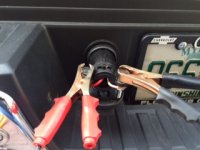 9. Viair Attached.jpg32.5 KB · Views: 78
9. Viair Attached.jpg32.5 KB · Views: 78 -
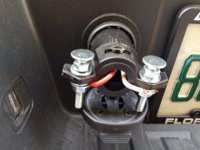 8. Plugged in and Ready to go.jpg35.1 KB · Views: 84
8. Plugged in and Ready to go.jpg35.1 KB · Views: 84 -
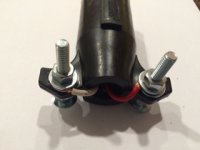 7. Wires to Power Studs.jpg21.6 KB · Views: 76
7. Wires to Power Studs.jpg21.6 KB · Views: 76 -
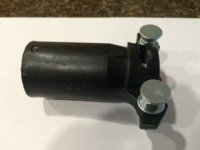 6. Power Studs Installed.jpg20.8 KB · Views: 73
6. Power Studs Installed.jpg20.8 KB · Views: 73 -
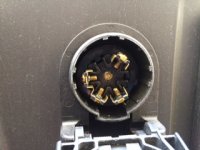 5. Plug installed for orientation 2.jpg36.3 KB · Views: 80
5. Plug installed for orientation 2.jpg36.3 KB · Views: 80 -
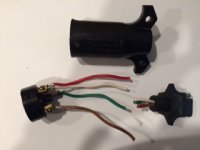 4. 7 Pin wires cut.jpg21 KB · Views: 76
4. 7 Pin wires cut.jpg21 KB · Views: 76 -
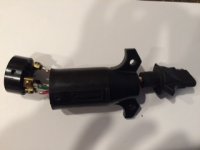 3. 7 Pin pulld apart.jpg17.9 KB · Views: 70
3. 7 Pin pulld apart.jpg17.9 KB · Views: 70 -
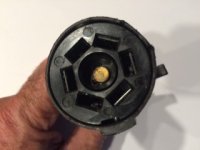 2. 7 pin showing connectors.jpg23.5 KB · Views: 62
2. 7 pin showing connectors.jpg23.5 KB · Views: 62 -
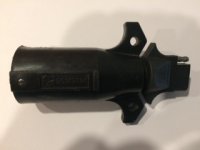 1. 7 pin adapter.jpg17.7 KB · Views: 62
1. 7 pin adapter.jpg17.7 KB · Views: 62
